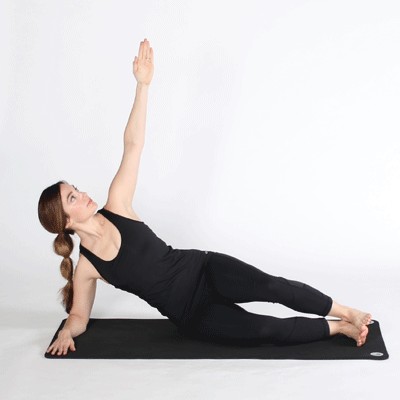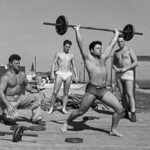It’s a common fitness goal: getting rid of those stubborn love handles. Many people search for targeted exercises, hoping to spot reduce fat in this area. However, achieving a leaner physique, especially around your midsection, requires a comprehensive approach. While specific exercises can strengthen and tone the underlying muscles, they alone won’t eliminate fat cells.
To effectively reduce love handles, combining cardiovascular exercise with strength training and targeted movements is key. If your goal is overall fat loss, aiming for up to five hours of moderate-intensity exercise per week can be beneficial. Coupled with a balanced diet, where you burn more calories than you consume, you’ll create the necessary calorie deficit for fat reduction. Incorporating aerobic activities like walking, cycling, and swimming into your routine supports gradual fat loss and sustainable weight management. Even small increases in daily activity contribute positively to your overall fitness journey.
Here are some effective exercises that target the back, abs, and hip regions, helping you strengthen your core and contribute to reducing love handles as part of a broader fat loss strategy.
Effective Exercises to Target Love Handles
These exercises focus on strengthening the core muscles, including the obliques, which are crucial for toning the area around love handles. Remember, consistency and proper form are essential for maximizing results and preventing injuries.
Side Planks
Side planks are excellent for working the oblique muscles, which run along the sides of your torso. They help improve core stability and strength. There are modifications for different fitness levels, making it accessible for beginners to advanced individuals.
To perform a basic side plank:
- Begin by lying on your side on a mat or comfortable surface.
- Position yourself on one forearm, ensuring your elbow is directly beneath your shoulder and your forearm is flat on the ground, perpendicular to your body.
- Stack your legs on top of each other, aligning your body in a straight line from your head to your hips and down to your feet. You can modify by keeping your bottom knee on the ground for less intensity while learning the form.
- Engage your core and lift your hips off the ground, maintaining a straight line.
- Squeeze your glutes and hold this position for 30 seconds to a minute as you get stronger.
- Focus on keeping your abdominal muscles engaged throughout the exercise to support your body and maximize muscle activation.
- Switch to the other side and repeat the exercise to work both sides of your core equally.
For a more challenging variation, lift both knees off the ground, balancing only on your forearm and the side of your bottom foot. You can also add hip dips by slowly lowering your hip towards the ground and then lifting it back up in a controlled motion for 30 seconds to a minute to further challenge your obliques.
Bicycle Crunches
Bicycle crunches are a dynamic exercise that effectively targets both the upper and lower abs, as well as the obliques. The twisting motion is particularly beneficial for working the muscles around the waistline.
To perform bicycle crunches correctly:
- Lie flat on your back with your hands gently placed behind your head, supporting your neck but not pulling on it. Bend your knees and lift your feet off the floor.
- Engage your abdominal muscles to lift your shoulders and head slightly off the ground, initiating the crunch motion. Keep your lower back pressed into the floor.
- Bring your right elbow towards your left knee while simultaneously extending your right leg straight out in front of you, keeping it elevated a few inches off the ground. Focus on twisting through your torso, not just your elbows.
- Reverse the motion, bringing your left elbow towards your right knee and extending your left leg straight out. Continue alternating sides in a pedaling motion, mimicking riding a bicycle.
- Maintain slow, controlled movements throughout the exercise, focusing on engaging your core muscles rather than rushing through the repetitions.
- Aim for 15 to 30 repetitions on each side to complete a set, ensuring proper form throughout.
Russian Twists
Russian twists are a seated core exercise that effectively targets the obliques and improves rotational core strength. This exercise can be modified to increase intensity by adding weight, making it suitable for various fitness levels.
Here’s how to perform Russian twists:
- Sit on the floor with your knees bent and feet flat on the ground. Engage your core and lean back slightly, maintaining a straight back and avoiding rounding your spine.
- Extend your arms straight out in front of you, clasping your hands together. For added resistance, you can hold a dumbbell, medicine ball, or even a water bottle.
- Lift your feet off the ground, balancing on your sit bones. For beginners or to reduce difficulty, you can keep your feet on the ground.
- Twist your torso to the right, bringing your hands or weight towards the right side of your body, aiming to touch the floor or as close to it as possible while maintaining control.
- Engage your core to twist back to the center, and then immediately twist to the left, bringing your hands or weight towards the left side of your body.
- Continue alternating twists from side to side in a controlled manner, focusing on using your core muscles to power the rotation.
- Repeat this exercise for 30 seconds to a minute, maintaining good form throughout.
Mountain Climbers
Mountain climbers are a dynamic, full-body exercise that not only strengthens your core but also elevates your heart rate, contributing to cardiovascular fitness and calorie burning. This exercise engages multiple muscle groups, including the abs, obliques, and shoulders.
To perform mountain climbers:
- Start in a plank position. To get into a plank, place your hands shoulder-width apart on the floor, directly under your shoulders. Extend your legs straight back, resting on your toes. Ensure your body forms a straight line from your head to your heels.
- Engage your core to maintain stability and prevent your hips from sagging or rising too high.
- Bring your right knee towards your chest, as if you are running horizontally, keeping your foot off the ground.
- Quickly switch legs, extending your right leg back to the plank position while simultaneously bringing your left knee towards your chest.
- Continue alternating legs in a rapid, controlled motion, resembling a running or climbing movement in a plank position.
- Maintain a steady pace and focus on engaging your core throughout the exercise. As you get stronger, you can gradually increase your speed.
- Continue mountain climbers for 30 seconds to a minute, or for a set number of repetitions.
Bridge
The bridge exercise primarily targets the glutes and hamstrings but also engages the lower back and core muscles, contributing to overall core stability and strength. It’s a great exercise for strengthening the posterior chain and supporting a healthy posture.
How to perform the bridge exercise:
- Lie on your back with your knees bent and feet flat on the floor, hip-width apart. Position your arms at your sides with your palms facing down.
- Engage your core and glutes. Press through your heels to lift your hips off the floor, creating a straight line from your knees to your shoulders.
- Squeeze your glutes at the top of the movement and hold this position for a few seconds. Ensure you are lifting with your glutes and hamstrings, not just your lower back.
- Slowly lower your hips back down to the starting position, controlling the movement rather than dropping quickly.
- Repeat this movement for 10 to 15 repetitions to complete a set.
To increase the challenge, you can perform single-leg bridges by extending one leg straight up towards the ceiling while lifting your hips, or by placing a weight across your hips.
Conclusion
Getting rid of love handles requires a consistent and holistic approach. While these targeted exercises can strengthen your core and obliques, remember that reducing overall body fat through a combination of cardiovascular exercise, strength training, and a healthy diet is crucial. Incorporate these exercises into your regular fitness routine and focus on creating a calorie deficit to effectively reduce love handles and achieve your fitness goals. Consistency and patience are key to seeing sustainable results.


